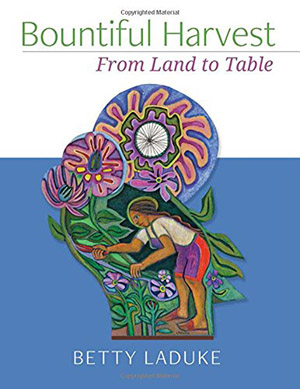[alert variation=”alert-info”]Publisher: White Cloud Press
Formats: Paperback, eBook, Kindle
Purchase: Powell’s | Amazon | IndieBound | iBooks[/alert]
Betty LaDuke is a prolific artist with a long career and an intriguing story. Born to Jewish parents in New York, she traveled to Mexico as a young artist and got to know the people who worked on the land. Then later, living in Oregon, she spent time on farms, studying the farmworkers both documented and undocumented, to make a series of paintings to honor them, for without them we would not have the fruits and vegetables that we eat, or the cut flowers for our tabletop vases. In this book, you can find not only the paintings, but also the stories of farm owners and their employees, picking everything from radishes to wine grapes.
LaDuke’s paintings are iconic, in the sense of the medieval church icons of saints: simplified down to the essential shapes, easy to understand, with a clear visual story that anyone can read. Her use of color has been honed over many years of practice, and she somehow balances many vibrant colors in one image without overloading it or making it look garish. The paintings vibrate with the energy of the natural world, as well as that of the farmworkers, and the way the workers stoop and hunch as they pick the produce is so clearly captured it almost makes your back ache as you look at the paintings.
The paintings are co-stars of the show with the workers’ stories. There are flower farmers who say that new workers often have a high turnover because they expect picking flowers to be glamorous and easy, but in fact it can be hot, itchy, and laborious. There is the Fry Family Farm, who really considers their workers to be like family, and their employee Raul, who sent the money he made on the farm back to his home in Mexico and whose sons eventually joined him at the farm. His path to citizenship was long, almost 20 years from arrival to citizenship. An orchard manager talks about how Mother Nature can devastate crops, and how new pests have arrived in North America in recent years, necessitating new developments in pest control. There is even a short segment from an interview with filmmaker Michael Moore, who inherited a vineyard and wisely decided to let the workers teach him how things should be done.
The stories from the workers and farm owners were more interesting to read and seem to flow better than the sections about LaDuke’s art and its effects on the community. The first section of the book, about LaDuke’s life and how she arrived at this subject matter, could have used some editing for clarity and given more of a sense of story. But the workers’ chapters were wonderfully edited in a way that showcased their individual voices.
The stories are illuminating, and you will have a new appreciation for where your food comes from after reading them. The work done on farms is extremely physical, time-sensitive, and intensely detail-oriented, and we depend on these workers for much of our food supply. Not only will you be dazzled by LaDuke’s paintings, you will learn many things from this book.
[signoff predefined=”Social Media Reminder” icon=”facebook”][/signoff]

